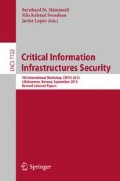Abstract
Critical Infrastructures are constantly affected by threats of various nature. Contingency planning in this context is needed in order to ensure an adequate management of emergencies. In particular, emergency response plans define the interactions and operations to be performed inside the infrastructure and among different systems during the occurrence of emergencies. The criticality of these systems need a proper methodology for the analysis of the designed emergency plans. In this paper we propose the Coloured Petri Net formalism as the basis for modeling and analysis of emergency response plans.
Access this chapter
Tax calculation will be finalised at checkout
Purchases are for personal use only
Preview
Unable to display preview. Download preview PDF.
References
CPN tools (2011), http://cpntools.org
Bammidi, P., Moore, K.: Emergency management systems: a systems approach. In: 1994 IEEE Int. Conf. on Systems, Man, and Cybernetics, vol. 2, pp. 1565–1570 (1994)
Dilmaghani, R., Rao, R.: A systematic approach to improve communication for emergency response. In: 42nd Hawaii Int. Conf. on System Sciences (HICSS), pp. 1–8 (2009)
ISO/IEC: Systems and software engineering – High-level Petri nets – Part 1: Concepts, definitions and graphical notation. Int. standard ISO/IEC 15909, ISO/IEC, Geneva, Switzerland, 1st edn. (2004)
Jain, S., McLean, C.: Simulation for emergency response: a framework for modeling and simulation for emergency response. In: 35th Winter Simulation Conference (WSC), pp. 1068–1076 (2003)
Jennex, M.E.: Modeling emergency response systems. In: 40th Hawaii Int. Conf. on System Sciences (HICSS), p. 22 (2007)
Kröger, W.: Critical infrastructures at risk: A need for a new conceptual approach and extended analytical tools. Reliability Engineering & System Safety 93(12), 1781–1787 (2008)
Liu, K.F.: Agent-based resource discovery architecture for environmental emergency management. Expert Systems with Applications 27(1), 77–95 (2004)
Merabti, M., Kennedy, M., Hurst, W.: Critical infrastructure protection: A 21st century challenge. In: 2011 Int. Conf. on Communications and Information Technology (ICCIT), pp. 1–6. IEEE (2011)
Moore, K., Abraham, J.: An architecture for intelligent decision support with applications to emergency management. In: 1994 IEEE Int. Conf. on Systems, Man, and Cybernetics, vol. 2, pp. 1571–1576 (1994)
Neal, D.: Reconsidering the phases of disaster. Int. Journal of Mass Emergencies and Disasters 15(2), 239–264 (1997)
Rinaldi, S.: Modeling and simulating critical infrastructures and their interdependencies. In: 37th Hawaii Int. Conf. on System Sciences (HICSS), p. 8 (2004)
SANS Institute: CIA confirms cyber attack caused multi-city power outage. SANS NewsBite 10(5) (2008)
Soyler, A., Sala-Diakanda, S.: A model-based systems engineering approach to capturing disaster management systems. In: 4th Annual IEEE Systems Conf., pp. 283–287 (2010)
Vespignani, A.: Complex networks: The fragility of interdependency. Nature 464, 984–985 (2010)
Wang, J., Tepfenhart, W., Rosca, D.: Emergency response workflow resource requirements modeling and analysis. IEEE Transactions on Systems, Man, and Cybernetics 39(3), 270–283 (2009)
Yang, F., Deng, L., Xue, D.: The construction and analysis of the universal model of emergency response. In: 18th Int. Conf. on Geoinformatics, pp. 1–5 (2010)
Zhang, Z., Zhou, Y., Cui, J., Meng, F.: Modelling the information flows during emergency response. In: 19th Int. Conf. on Geoinformatics, pp. 1–5 (2011)
Zhong, M., Shi, C., Fu, T., He, L., Shi, J.: Study in performance analysis of china urban emergency response system based on petri net. Safety Science 48(6), 755–762 (2010)
Author information
Authors and Affiliations
Editor information
Editors and Affiliations
Rights and permissions
Copyright information
© 2013 Springer-Verlag Berlin Heidelberg
About this paper
Cite this paper
Cheminod, M., Bertolotti, I.C., Durante, L., Valenzano, A. (2013). Modeling Emergency Response Plans with Coloured Petri Nets. In: Hämmerli, B.M., Kalstad Svendsen, N., Lopez, J. (eds) Critical Information Infrastructures Security. Lecture Notes in Computer Science, vol 7722. Springer, Berlin, Heidelberg. https://doi.org/10.1007/978-3-642-41485-5_10
Download citation
DOI: https://doi.org/10.1007/978-3-642-41485-5_10
Publisher Name: Springer, Berlin, Heidelberg
Print ISBN: 978-3-642-41484-8
Online ISBN: 978-3-642-41485-5
eBook Packages: Computer ScienceComputer Science (R0)

